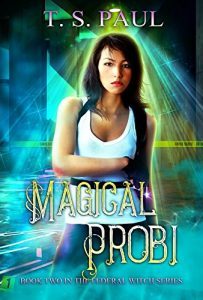Cora Buhlert's Blog, page 93
December 31, 2016
New Year 2017
Here in Germany, it has been 2017 has been here for about five hours now and on Times Square, that crystal ball should be dropping soon.
But first, let’s have some photos of holiday decorations at Roland Center mall here in Bremen.

Holiday decorations at the Roland Center mall in Bremen.

More holiday decorations at the Roland Center mall in Bremen.

A closer look at the big Christmas tree at the Roland Center mall. The Peek & Cloppenburg store in the background, one of the anchor stores, recently closed.
I’ve never been one for big parties (been there, done that) and with the heightened security concerns this year, going out to one of the big parties would have been even more of a hassle, since they probably wouldn’t let you in anywhere without extensive security checks.
So I went to a local Italian restaurant with my parents for New Year’s Eve dinner. They had a set menu. Here are some photos:

The first course of the New Year’s Eve menu was a platter of mixed antipasti.
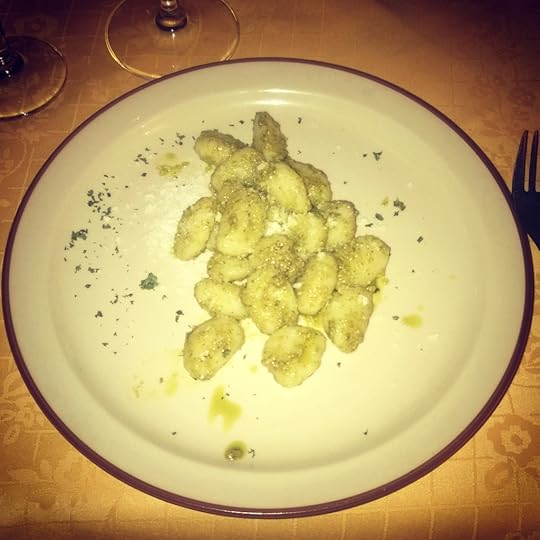
The pasta course of the New Year’s Eve menu was gnocchi with pesto.

The main course of the New Year’s Eve menu was pork medallions in masala sauce with mediterranean vegetables and potatoes.
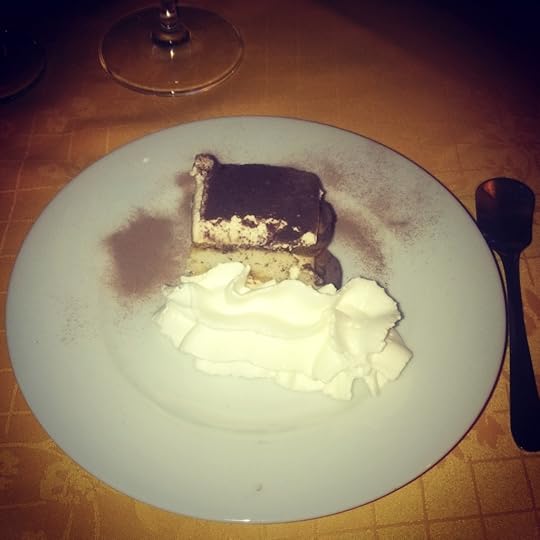
The dessert for the New Year’s Eve menu was Tiramisu.
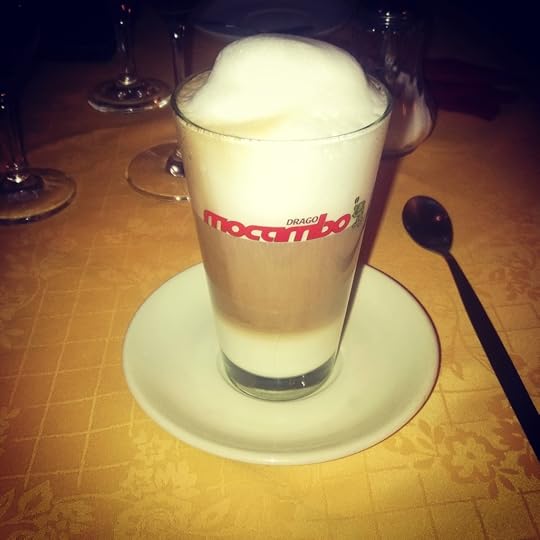
And finally, a latte macchiato for the way home.
We got home at about a quarter to eleven with about an hour to go until midnight. I found that some of my students had sent me What’s App messages, wishing me a Happy New Year, which was very nice.
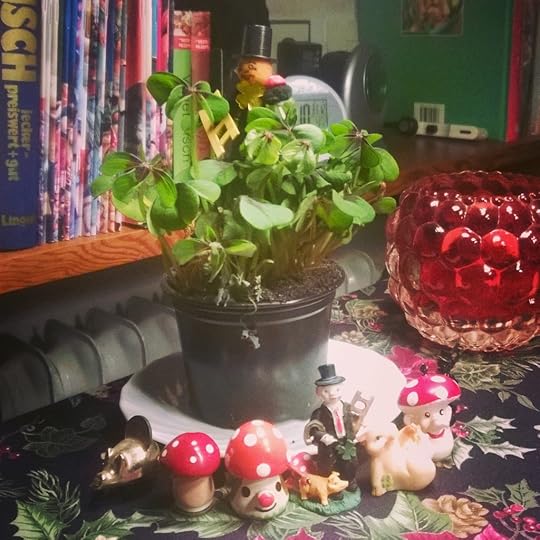
A lot of good luck symbols and a lucky clover plant for a happy new year.

The champagne is open, the glasses are full, 2017 can come.
My Mom’s glasses are vintage lead crystal BTW and really, really nice. Much nicer than mine, at any rate.
After a few sips of champagne, it was time for the fireworks. Now New Year’s Eve 2016/2017 has definitely been the most intense year for fireworks I’ve ever seen. Of course, this year we had the full legal sales period for fireworks from December 29 to 31, i.e. the full three days. Some years, there is a Sunday in the way and one day is missing.
The fireworks marketing was also more intense than in previous years. Most stores had extra flyers for their fireworks, Aldi – which is one of the biggest sellers of fireworks – extended their opening hours and apparently had videos previewing the firework effects on their website, which seem to have vanished now.
And there certainly was a whole lot of firework in my parents’ normally quiet semi-rural/semi-suburban neighbourhood. More than I can ever recall seeing there. By sunset on New Year’s Eve, it sounded like World War III had broken out outside and December 30 wasn’t much better.
As for why there was so much more firework this year, I suspect part of the reason may be demographics. Several families in my parents’ neighbourhood have school aged or teenaged kids who love fireworks. Plus, the Lebanese family who moved in a bit down the road had enough fireworks that the entire street was blocked with spent fireworks batteries. They kept shooting fireworks up to approx. 2 AM, long after everybody else had stopped. And the Russian family who moved into the house directly behind my parents’ after the elderly lady who’s lived there for as long as I can remember had to move into a nursing home not just started their fireworks early, they also had a New Year’s Night barbecue in the garden.
Another reason for the increase in fireworks this year might be that more and more people are opting for fireworks batteries, which offer more bang for buck – literally – than for single shot rockets and firecrackers. We only had a single battery this year, 100 shots (according to the packaging – actually, I think it was fewer) for 6.99 Euro. You really can’t beat that price, especially since the cheapest rocket pack cost 9.99 Euro.
Finally, I suspect that we weren’t the only people who opted to go only for dinner or stay at home altogether this New Year’s Eve. Terrorism fears and the whole heightened security circus probably put a lot of people off. Never mind that you can’t shoot fireworks in the party zones in most cities anymore – which is a good thing, because the risk of injury or accidental fires is much greater there. So the suburbs get more fireworks.
Photographing fireworks is always tricky, but I managed to get some good shots.

New Year’s Night Fireworks

More fireworks.

And even more fireworks.

Fireworks with a neat crackling star effect.

A fireworks battery in the process of firing.
And that’s it for tonight. A happy new year to all my blog readers and followers and may 2017 be a better year for all of us than 2016 was.
 Send to Kindle
Send to Kindle
December 30, 2016
Indie Speculative Fiction of the Month for December 2016
 It’s that time of the month again, time for “Indie Speculative Fiction of the Month”.
It’s that time of the month again, time for “Indie Speculative Fiction of the Month”.
So what is “Indie Speculative Fiction of the Month”? It’s a round-up of speculative fiction by indie authors newly published this month, though some November books I missed the last time around snuck in as well. The books are arranged in alphabetical order by author. So far, most links only go to Amazon.com, though I may add other retailers for future editions.
Once again, we have new releases covering the whole broad spectrum of speculative fiction. This month, we have urban fantasy, epic fantasy, space opera, military science fiction, post-apocalyptic science fiction, dystopian fiction, science fiction romance, paranormal romance, vampires, werewolves, trolls, robots, starships, crimson queens, genetically engineered dragons, alien bounty hunters, Venusian affairs, telepaths, miracle drugs, brainwashed soldiers, monsters in the woods, Christmas in space and much more.
Don’t forget that Indie Speculative Fiction of the Month is also crossposted to the Speculative Fiction Showcase, a group blog run by Jessica Rydill and myself, which features new release spotlights, guest posts, interviews and link round-ups regarding all things speculative fiction several times per week.
As always, I know the authors at least vaguely, but I haven’t read all of the books, so Caveat emptor.
And now on to the books without further ado:
 Emperor of the Fireflies by Sarah Ash:
Emperor of the Fireflies by Sarah Ash:
Sparks… glittering like fireflies against the night sky…
Kai and Masao, once enemies, are now condemned to the sea by the Tide Dragons Sacrifice. If Hotaru, the new emperor, is unable to summon the Tide Dragons of Ebb and Flood at the Autumn Moon Festival, he will forfeit the right to rule Cipangu. The two Sacrifices face a desperate race against time to free themselves from this ancient curse before Hotaru binds them with forbidden magic to obey his will – forever.
Sakami, Kai’s lover, has become a kitsune, a fox spirit. She is determined to do all in her power to save him – but is Hotaru, aided by his treacherous shikigami, Kurika, just too formidable an opponent to overcome?
Jonah Winter has developed the perfect creativity enhancing drug – one hundred percent effective, non-addictive and safe.
Ron Varnhagen has experienced the drug’s remarkable properties for himself and plans to invest in Jonah’s venture. But then he learns of the horrifying secret behind the drug and its production…
This is a short science fiction story of 2600 words or approx. 10 print pages altogether.
In the corrupt city of Mei Jhabo, a mysterious new thoughtenhancer has devastating effects on the consumer’s brain. Its emergence is linked to the sudden rise of one of the city’s most ruthless drug gangs. Leading the fight against it, Commissioner Celia Wallace employs the services of the famous Ayers-Ross Thoughtprotection Agency. Their mission: retrieve an undercover agent sent to infiltrate the gang and protect the information inside his mind.
For ambitious young telepath Alex Lea, this seems like the perfect opportunity to prove that he is a worthy successor to his idol, legendary Mindguard Sheldon Ayers. But, in this profession, the course of things can change in an instant.
After an ambush leaves him separated from his team, Alex must learn to become his own guardian first. Pushed to the limits of his ability, he comes across an enemy far more dangerous than anyone suspects and a plot that threatens the very future of the Federation.
AYERS is a prequel set a few months before the events of MINDGUARD. It can be read as a stand-alone or at any point in the series. For reasons pertaining to themes and character study the author recommends reading the books in order of publication.
In the void, the Shadows lurk, waiting to arise.
Jas Harrington and the crew of the Galathea have made it back to Earth. Now they face an investigation into the Shadow attack on the ship and the infiltration of the colony world of Dawn.
They find that things have changed since they went away. Strange disappearances and odd behavior lead them to the question: have the Shadows invaded their home planet?
When the former navigator Sayen Lee investigates, she’s taken hostage. Can Jas get her back? And can they find out what’s been happening on Earth before more lives are lost?
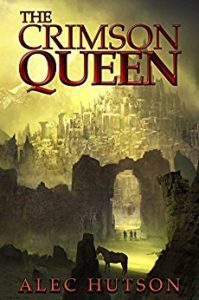 The Crimson Queen by Alec Hutson:
The Crimson Queen by Alec Hutson:
Long ago the world fell into twilight, when the great empires of old consumed each other in sorcerous cataclysms. In the south the Star Towers fell, swallowed by the sea, while the black glaciers descended upon the northern holdfasts, entombing the cities of Min-Ceruth in ice and sorcery. Then from the ancient empire of Menekar the paladins of Ama came, putting every surviving sorcerer to the sword and cleansing their taint from the land for the radiant glory of their lord.
The pulse of magic slowed, fading like the heartbeat of a dying man.
But after a thousand years it has begun to quicken again.
In a small fishing village a boy with strange powers comes of age…
A young queen rises in the west, fanning the long-smoldering embers of magic into a blaze once more…
Something of great importance is stolen – or freed – from the mysterious Empire of Swords and Flowers…
And the immortals who survived the ancient cataclysms bestir themselves, casting about for why the world is suddenly changing…
 Mission: A Venus Affair by V.A. Jeffrey:
Mission: A Venus Affair by V.A. Jeffrey:
Bob and his family are going on a much-needed vacation towards the hottest destination in the solar system: Vepaja City, Venus! But as soon as they reach Venus someone from his past makes an inconvenient request: make a secret deal that promises to benefit Bob, U-net and the Boss. Who is this mysterious character? Does this person really care about helping him or is there a darker agenda? Is this side mission really in Bob’s best interest? If he agrees to the deal U-net could reap an advantage in the coming war. But is this mission legitimate or is it a trap?
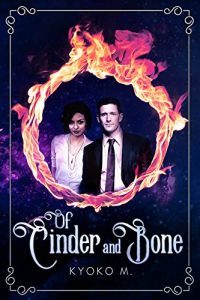 Of Cinder and Bone by Kyoko M.
Of Cinder and Bone by Kyoko M.
After centuries of being the most dangerous predators on the planet, dragons were hunted to extinction. That is, until Dr. Rhett “Jack” Jackson and Dr. Kamala Anjali cracked the code to bring them back. Through their research at MIT, they resurrected the first dragon anyone has seen alive since the 15th century. There’s just one problem.
Someone stole it.
Caught between two ruthless yakuza clans who want to clone the dragon, Jack and Kamala brave the dangerous streets of Tokyo to steal their dragon back in a race against time before the world is taken over by mutated, bloodthirsty monsters that will raze it to ashes.
Of Cinder and Bone is an all-new sci-fi thriller from the author of the Amazon bestselling Black Parade novels. Don’t miss out on this explosive first-in-series!
 Rayzor’s One by Michele Mills:
Rayzor’s One by Michele Mills:
Rayzor of Twelve, a lonely Bounty Hunter banished from his home world, is determined to follow his mission parameters: He must extract his target from a primitive planet called Earth with zero human casualties.
His plan unfolds with precision, until a human female gets in the way.
Rebecca doesn’t understand what the hell is happening. One moment she’s scared and alone in the spooky forest. Then a seven foot tall alien warrior is gazing at her with dark passion, his clawed hands touching her reverently. He’s kissing her, claiming her and saying, his voice hoarse with emotion—that she is his Bride.
His Bride? Wtf?
This stranger is swoon-worthy, but…She doesn’t know his name, or what species he is and he’s kidnapped her, thrown her on his goddamn spaceship and now she’s speeding away from Earth to parts unknown. And he expects her to fall into his arms?
Oh hell, no.
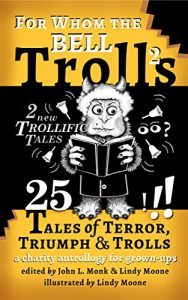 For Whom the Bell Trolls, edited by Lindy Moone and John L. Monk:
For Whom the Bell Trolls, edited by Lindy Moone and John L. Monk:
It’s a Smorgasbord of Trolls!
Funny, touching, titillating and suspenseful, there’s a story for every adult reader in For Whom the Bell Trolls, a unique, illustrated “antrollogy” by 24 international authors. Arranged from light to meaty fare, the book’s “menu” offers up fanciful and farcical stories, family-oriented tales, romance, mystery, even magically surreal literary stories — starring all sorts of trolls, from the all-too-real Internet variety to the man-eating, bridge-dwelling trolls of legend.
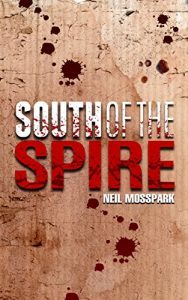 South of the Spire by Neil Mosspark:
South of the Spire by Neil Mosspark:
Three weeks after a southern exploration team left the Citadel to map the unknown lands to the south, their cartographer’s journal was found stuffed into the hollow of a tree. It accounts the southern exploration team’s journey, documenting the ruins of ancient man, and the threats encountered in the post-apocalyptic forest.
… There are more than just wild things in the wilderness.
 Ghosts of Noodlemass Past by T.S. Paul:
Ghosts of Noodlemass Past by T.S. Paul:
The War with Earth looms over everything. It is overshadowing even Noodlemass, the Holiday Celebration of Athena Lee’s planet. Refugees have no where to go and children are trapped out in the cold without shelter. The best solution is to use local Hotels to put them up for the winter. One problem with that. The owner won’t sell or even lease.
What will Wilson and his gang of cybernetic heroes do to help? Wilson provides his unusual spin on a Christmas Classic!
Torn from her parents at a young age, Katherine is raised in a pack of werewolves like herself and brought into the ways of the Hounds of God: An army of werewolves that will bring justice to evildoers.
But when their leader is killed and everything Katherine has believed is thrown on its head, she sets off with a small group of friends in search of a cure to what she now believes is a curse.
This search for a cure leads her to a fight for survival where she’s challenged to embrace the beast within. Will she give up everything to stop the nefarious army of werewolves, betraying those she once considered family?
 Justice Is Calling by Justin Sloan and Michael Anderle:
Justice Is Calling by Justin Sloan and Michael Anderle:
The History of the World wasn’t what Valerie was taught.
The daughter of a vampire and sister of a devil walking, Valerie finds out she has something neither her brother nor her father possess:
She has Honor.
Now, she needs to flee a brother who leaves her for dead. Because, if there is one thing Valerie understands?
It’s that Justice Doesn’t Turn the Other Cheek.
150 years after a near apocalypse, the world is rebuilding. Survival has become the only rule, and justice is in short supply. Now, Justice has come calling.
 Shades of Honor by Sandy Williams:
Shades of Honor by Sandy Williams:
She won her freedom. Can she win a war?
Commander Rhys Rykus is facing court martial. With his career on the line, he’s ordered to keep his distance from the brainwashed Ash and protect her from afar, but sinister elements threaten her safety. He accepts a new mission that puts them on the same warship, knowing it will take all his self-control to fight his feelings for her.
Lieutenant Ramie Ashdyn is no stranger to fighting for her life. Still under the influence of the Coalition’s brainwashing, she cares little for her own safety. She merely wants to protect the Coalition… and reconnect with Rykus.
Rykus knows how important Ash is to keeping all of them alive, but the target on her back is enormous. Will the growing threat to the Coalition take down Ash and Rip’s only shot at love?
 Send to Kindle
Send to Kindle
December 28, 2016
Rest in Peace, Carrie Fisher and George Michael, and Fuck 2016
The annus horibilis of 2016 has struck once more, because after the death of George Michael on Christmas Day, we also lost Carrie Fisher yesterday, aged only sixty, following her heart attack on December 23. And her mother Debbie Reynolds followed her only a day later, aged 84. I can’t even begin to imagine how horrible this must be for their surviving family.
And just because they shouldn’t be forgotten, yesterday also claimed the lives of Richard Adams, author of Watership Down, who died aged 96, American actor Ricky Harris, who died aged only 54, and British actress Liz Smith, who died aged 95. And today, German singer, songwriter and musician Knut Kiesewetter became the hopefully last notable victim of 2016, when he died aged 75 (a former president of the German Central Bank also died, but his death was mostly greeted with shrugs and “Who was this guy?”).
All this happens at the end of a year that has already claimed the lives of Alan Rickman, David Bowie, Prince, Robert Vaughn, Leonard Cohen, Götz George, Manfred Krug, Bud Spencer, Sir Ken Adam, Tanith Lee, Zsa Zsa Gabor, George Kennedy, Guido Westerwelle, Hans Dietrich Genscher, Hildegard Hamm-Brücher, Walter Scheel (Was 2016 trying to exterminate the FDP, too?), Jutta Limbach, Fidel Castro, Tamme Hanken, Umberto Eco, Harper Lee, Gene Wilder, John Glenn, Anton Yelchin, Uwe Friedrichsen, Roger Willemsen, Roger Cicero, Erika Berger, Peter Lustig, Maja Maranow, Muhammad Ali, Sonia Rykiel, Vera Rubin, Rick Parfitt, Alan Thicke and whoever I have forgotten.
Indeed, the “Let us remember the artists who left us in 2016” bit at the end of the news today had to be hastily amended with “George Michael and Carrie Fisher died as well”. I did not watch the special obituary edition of Markus Lanz’s show afterwards and the one time I did tune in, there was Andreas Gabalier murdering Leonard Cohen’s “Hallelujah”, so I quickly switched off again.
Is this sheer amount of deaths in 2016 (along with all the other awful things that happened) unprecedented? I’m not sure, since a lot of people, including famous people die every year. But it certainly seems as if 2016 saw the loss of many people who were important to me and touched my life in some way. Many of these people were giants and icons of my childhood and teen years.
The loss of Carrie Fisher and George Michael within days of each other hit me harder than most of the 2016 deaths (though Alan Rickman, Götz George and Sir Ken Adam also hit me hard), because I was a huge fan of both of them.
Along with the rest of Germany, I probably saw George Michael for the first time, when Wham! performed “Young Guns” on the legendary music program Musikladen back in 1983 (here’s a clip, complete with host Manfred Sexauer, who left us two years ago), because my Mom and I always watched Musikladen (and in fact, my Mom had been watching since the very first episode back in 1965). But I didn’t became a fan until “Wake Me Up Before You Go Go” came out a year later. I have a “My Class” book from the period (this is the exact book I had in the early 1980s), where everybody filled out his favourite colour, movie, book, song, etc… and every second kid wrote down “Wake Me Up Before You Go Go”, because everybody loved that song.
I don’t think I knew George Michael’s name then – at the time, I did not care about the names of singers or their personal lives and only remembered the names of artists once I realised that it made recording songs you liked off the radio easier. But I certainly loved his music, “Take Me to the Edge of Heaven”, “I don’t want your freedom”, “I’m Your Man”, “Careless Whispers”, “A Different Corner”, “Club Tropicana” and of course, “Last Christmas”, which is my favourite of all modern Christmas songs and the one where I will inevitably turn up the volume, once it comes on. Coincidentally, the central characters of two different Christmas romances I wrote, Christmas Eve at the Purple Owl Café and Christmas Shopping with a Broken Heart, share their first kiss to “Last Christmas”. Because it’s simply that great a song.
By the time, George Michael left Wham! and started his solo career, I certainly knew his name. My cousin had a huge crush on him. She didn’t know he was gay and I don’t think I did either, though it’s bleedingly obvious in retrospect. Not that I would have cared, I loved the music, not the man. I remember dancing along alone in my room to “Faith” and “Monkey”, I remember writing the lyrics to “Father Figure” into my diary, I remember how I and a couple of friends scared the older brother of a friend half to death by singing and dancing along to “I want your sex” at a birthday party. “I want your sex” is still on my “I have to write a sex scene and need to get inspired” playlist.
Through much of my life, George Michael’s music was always there. I have four CDs with his music, more than by pretty much every other artist. He has written so many songs I love that I have a hard time picking a favourite (and I just realise I forgot to mention “Cowboys and Angels”, which is also on “I need to write a sex scene” playlist). I’m heavily music synaesthetic, which means that I don’t just get colour and taste with music (though I get that, too), but whole mini movies, provided the music is good. I always got mini movies with George Michael’s music.
A lot of the imagery I get for pop music from the 1980s is space-themed in some way, because this was also the time I became first a Star Wars and then a huge SF fan in general. Which brings me to Carrie Fisher, who is certainly part of the reason why I am an SF fan today.
Back in the late 1970s and early 1980s, there were not a whole lot of role models for girls who weren’t fainting damsels in distress or older mother and housewife types. Even Charlie’s Angels, who were pretty awesome and kick-ass, answered to a man. The lone exception was science fiction, because SF gave us Uhura and Tamara Jagellowsk and Janice Rand and Dr. Helena Russell and Athena and Sheba and Cassiopeia and of course, Princess Leia.
I still remember how I first encountered Princess Leia, in action figure form during a show and tell session in a kindergarten in Biloxi, Mississippi, in 1978, clutched in the hand of a classmate along with Han Solo (that kid knew who the best characters were). Many of my classmates at the time were obsessed with something called Star Wars, which I hadn’t seen and wasn’t allowed to see. But up to that point, all the Star Wars characters I’d seen were either robots or scary people in masks or monsters or young men, none of which seemed very interesting. This Princess Leia was different. For starters, she was a princess and like every little girl aged five, I loved princesses. Plus, she had the most gorgeous gown and fabulous hair, which was a huge thing, when you were a kid forced to wear pants all the time (because it as practical) and always had your hair cut so short you got mistaken for a boy (but it was practical). And I decided there and then that I wanted to look just like her.
So I refused to have my hair cut short anymore and announced that I wanted to have long hair from now on (and I still do). I also rebelled against the all pants all the time (especially since pants aren’t all that comfortable, if you’re still growing) and insisted I wanted to wear dresses. I spent the next several years trying to look like Princess Leia. I came close at times (and I wished I had a photo of ten-year-old me with a Leia hairstyle, but no one was nice enough to take one), though I never fully succeeded, probably because no real world human being can ever really look like Leia without a lot of Hollywood magic, not even Carrie Fisher herself.
I never had Star Wars toys as a kid, until I bought them years later at the flea market (and of course I have the action figure of Leia in that iconic white gown, the same one my classmate so long ago had). It even took me years to actually get to see the movies, since my parents did not get that “I think this movie looks interesting and people are talking about it at school” translated as “I really, really want to see this, so take me there.” And though my Mom had no compunctions about dragging me to see The Name of the Rose, when I was really much too young for it, Star Wars or Indiana Jones or indeed anything I really wanted to see was deemed too scary for me.
Though when I finally did get to see the Star Wars movies, I realised that Princess Leia was even more amazing than I’d thought. She spits at Darth Vader, mouthes off to Tarkin, withstands torture and utterly fails to be impressed by her would-be rescuers Luke and Han, once they show up, and promptly takes charge of her own rescue, which particularly impressed my young self, because the princesses I was used to never did that. She continues to impress throughout the original trilogy, leading the Rebellion, helping to repair the Millennium Falcon, kissing Han Solo, threatening Jabba with a bomb and then strangling him with the chains he uses to bind her, befriending Ewoks, shooting Stormtroopers, kissing Han Solo some more. And by the time, The Force Awakens came around, Leia is still leading the Rebellion, now promoted from Princess to General and showing all those little girls who once wanted to be her that life doesn’t end at forty or fifty. Obi Wan and Yoda both had it wrong. Leia was clearly the most impressive of the Skywalker siblings.
But while I could not watch the movies until they finally hit German TV, what I did have was a box full of newspaper and magazine clippings with pictures of Star Wars characters and other stills from SF movies and toy catalogues from the early 1980s featuring Star Wars action figures. I still have that box, too, somewhere. I know it’s purpose is gone now I can watch the actual movies anytime I want, but I can’t bear to throw it away, because those clippings once meant so much to me.
I also have a collection of film books and magazines from the 1980s, which still fall open at the pages featuring Star Wars all those years later. I also have the Star Wars novelisations – in English – even though I had to special order them from the bookstore at a time when that was enormously expensive and took ages. I still remember having to paintakingly spell out the title of The Empire Strikes Back to a bookstore clerk.
Indeed, I suspect that I learned Carrie Fisher’s name from one of those clippings or magazines. At any rate, I promptly set out to watch any movie she ever made, like I did with any of the other Star Wars cast. This is how I came to see Under the Rainbow and The Burbs and Blues Brothers (okay, a friend forced me to watch that one, but once Carrie Fisher showed up, brandishing that rifle, I actually enjoyed it). Carrie Fisher’s appearance in it also definitely contributed to my decision to watch Harry and Sally, though a Time Magazine review of the movie I read on a plane also helped to persuade me. I sneaked the magazine off the plane (though I supposed I need only have asked if I could have it) and made everybody I knew read that review, trying to persuade them that we needed to watch that movie. The magazine is in my box, along with the newspaper clippings.
In spite of my collection of newspaper and magazine clippings, I did not know much about Carrie Fisher’s personal life. I knew that her parents had been Hollywood stars themselves and that she’d been married to Paul Simon, but that was about it. I certainly did not know about her struggles with addiction (nor about George Michael’s, for that matter), until the movie version of Postcards from the Edge came out. That’s probably for the better, because with the strict anti-drug education of the 1980s, it was a serious topic of discussion whether you were even permitted to consume and enjoy art and music made by people taking drugs, because – and no, I don’t get the reasoning behind that one either – consuming art and music made by people who take drugs somehow made you more likely to take drugs yourself. Given that the teachers who promoted that sort of crap were part of the sixties generation and many of their idols had already expired from drug use, that whole attitude was even more hypocritical (and pisses me off even thirty years later). Nonetheless, it was a sadly common attitude at the time. And so I’m glad that teenaged me did not know about Carrie Fisher’s and George Michael’s struggles with addiction and that I only found out when I was ready to handle that knowledge. Because that way, I got to enjoy their art without worrying whether it was wrong to do so.
Given the backlash still facing public figures, particularly women, who admit to struggling with addiction and mental illness, it is even more remarkable that Carrie Fisher chose to be so open about her problems. And indeed it was Carrie Fisher’s utter frankness about her life and her illness that made us realise she was not just a talented actress who happened to play an iconic character, but a remarkable woman and feminist icon in her own right. Quite a few tributes I’ve seen (I’m collecting a bunch of them for the weekly link round-up over at the Speculative Fiction Showcase) focus on this aspect of her life. One of my favourites is this collection of 15 of Carrie Fisher’s most memorable feminist lines at New York Magazine.
As always when public figures who have touched a lot of lives die, there are those who simply have to police the way other people choose to remember the dead. There’s a tweet going around berating people for mourning Carrie Fisher and George Michael, but not Donald Henderson, former head of the CDC who was instrumental in the eradication of smallpox and who died in August 2016.
And then there is this truly awful editorial from the Guardian, which claims that we mourn dead celebrities as a replacement for religion and because we don’t have enough real friends.
For starters, I really hate any “X is a replacement for religion” pronouncements, usually made my people who can neither understand that people manage to live just fine without religion nor why someone would enjoy X for its own sake. So X – whereby X can be football, science fiction, superhero movies, sports not football, fandom, etc… – simply has to be a replacement for religion. Such pronouncements are not just clueless, but also massively offensive. I’m not religious and – amazingly – I’m not missing anything. If I was, I know where the local church is. And the local mosque. And the local Hindu temple. I could also locate the nearest synagogue, if I wanted to. However, I am a lifelong science fiction fan. Not because I miss religion, but because I love SF. I’ve also been a fan of both George Michael and Carrie Fisher. Not because I miss religion, but because the art they made was important to me.
I also don’t get why people feel the need to police who and how we mourn. There are mourning rituals I don’t get, e.g. public memorials of flowers, votive candles and stuffed toys or crosses set up at the site of deadly road accidents (which wasn’t a thing in Protestant parts of Germany until about twenty years ago and still seems strange to me). But I wouldn’t dream of telling people they shouldn’t put up those crosses or lay down those flowers. It helps those who engage in those practices. It doesn’t have to help me.
On a similar note, I resent that I am expected to feel more deeply about the recent terrorist attack on a Berlin Christmas market than about any of the other many terrorist attacks of 2016 in Brussels, Nice, Istanbul, Jordan, Afganistan and elsewhere, simply because the Berlin attack happened in German soil. For even though Berlin happens to be the German capital, I don’t have close connections to the city. I have been there a handful of times in my life (including at the place where the attack happened, since it’s a prominent part of the city), all of them years ago. I don’t have any friends or family who live in Berlin and I don’t know anybody who was directly affected by the attack. But somehow, caring more deeply about the loss of two artists who shaped my youth than about a terrorist attack in a city I have little connection to makes me a bad person.
People have the right to mourn whom and how they choose. I never quite got the intense reactions to the death of Princess Diana (and only her, no one beyond their families cared much about Dodi Al Fayed and the driver who were also killed), for though her early death of tragic, it wasn’t a world stopping event for me. Nor do I get the equally intense reactions to the assassination of John F. Kennedy or people weeping over the death of Pope John Paul II. I don’t remember the death of Elvis, but I do remember when John Lennon was killed and I was very confused (I was seven at the time) how many people were sad that a man I’d never heard of had died. That the radio only played “Imagine” and not the Beatles songs I’d actually have recognised didn’t help either. But while these deaths didn’t elicit the same reactions in me, they clearly meant a whole lot to many other people. And who am I to tell them they’re wrong?
Ann Leckie puts it even better in this post on her blog about mourning rituals and what their purpose really is. And indeed, I have been to funerals of people who had less impact on my life than either George Michael or Carrie Fisher, neither of whom I’ve ever met. I still went to honour the dead and their families. And my presence as well as everybody else’s presence seemed to comfort the close relatives of the deceased.
So the ever grumbling pundits should just allow us to mourn the passing of the icons of our youth, even if they weren’t the icons of their youth.
So rest in peace, Carrie Fisher, George Michael, Debbie Reynolds and everybody else we lost in 2016 and may the Force be with you all.
 Send to Kindle
Send to Kindle
December 26, 2016
Christmas 2016
It’s time for the annual Christmas post, complete with photos, again.
Of course, the annus horiblis 2016 couldn’t even let up over the holidays and so actress Carrie Fisher suffered a massive heart attack and ended up in intensive care aged 60, while singer George Michael died of heart failured aged only 53. I am a big fan of both of them. And indeed it’s telling that among 2016’s many death of famous and notable people, there were hardly any arseholes, jerks and people the world won’t particularly miss. With the possible exception of Fidel Castro (and my personal views don’t match the standard US view in his case) and one or two retired politicians, most of the notable dead of 2016 were popular and beloved.
Meanwhile, here in Bremen, Christmas was warm, wet and windy. I spent the holidays with my parents. My uncle came over for lunch on Christmas Day, but otherwise we were on our own. And since I forgot my camera, all pics that follow are smartphone photos.

My Mom, my uncle and my Dad sitting at the table for Christmas Day luch.
The Christmas Tree
As always, I decorated the Christmas tree. This year’s tree, from my parents’ garden, had grown unevenly and also had a spot with hardly any branches in the middle, so decorating it was a challenge. Still, all things considered, I think I didn’t do too badly. Let’s take a look:

An overall view of the fully decorated and lit Christmas tree.

A look up the tree. The beeswax candles burn only for about half an hour under constant supervision. The LED light strings were purchased last year, since getting replacement bulbs for our old fairy lights was difficult.

A close-up view at the mid section of the tree. In the middle, you can see the barren part of the trunk, covered by clip-on twin angel ornaments from the 1960s. Also note the Tasmanian devil and the trio of Disney characters.

A close-up look at the top of the tree. These ornaments are some of the oldest. Many are around 50 years old and incredibly delicate. The big wood shavings angel is a personal favourite.

A side view of the top half of the tree. The apple ornaments are construction paper cut-outs and fifty years old.

A close-up look at the lower part of the tree with several porcelain ornaments and a reindeer. You can also see the construction of the candle holders with a counterweight.

I call these two ornaments, Santa and a little guy with a hat, Gandalf and Bilbo, because they kind of look like them. We also have the dwarves, all thirteen of them.

And here are two of the dwarves (and a cuckoo clock). The one with the black beard of Thorin Oakenshield.
I noticed the resemblance of some of the ornaments to Hobbit characters in 2012, when the first part of The Hobbit trilogy hit the theatres and set about assembling the whole adventuring party just for fun. .
Other Holiday Decorations

Department store mannequin Else is on the look-out for Santa in this atmospheric shot.

Here we have a parade of votive candle holders. The glowing Virgin Mary inspired my story “Our Lady of the Burning Heart”.
Christmas Presents
So let’s take a look at the presents. Like every year, I asked for books and got them. I’m also getting a new PC just after the holidays, though it’s not a Christmas gift, just a regularly scheduled upgrade.

Wrapped Christmas presents (my Dad’s)

Unwrapped Christmas presents (my Dad’s). The calendar is censored for obvious reasons.

Wrapped Christmas presents (my Mom’s).
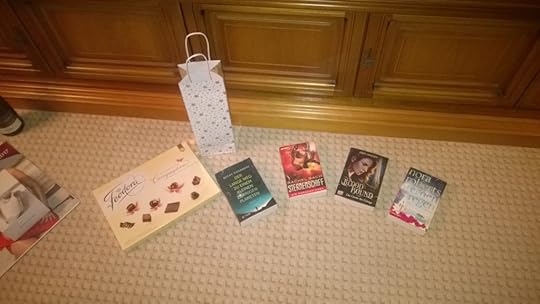
Unwrapped presents (my Mom’s).

Wrapped presents (mine). Plus, K-S20 from Star Wars: Rogue One.
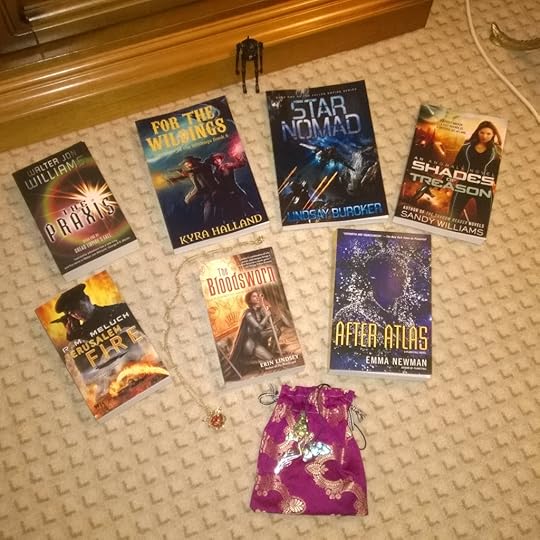
Unwrapped Christmas presents (mine). Lots of books and jewellery and one droid. I also got a bar of soap, which is not pictured here.
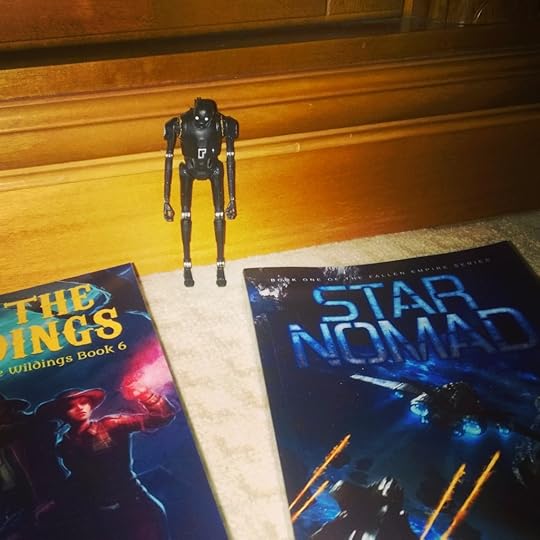
K-S20 skeptically eyes these books. Are these suitable reading for the discerning droid?
Coincidentally, K-S20 is the only character from Rogue One I’ve been able to find in action figure form. All other Rogue One action figures are standard Stormtroopers and Darth Vader, because obviously there aren’t enough Stormtrooper and Darth Vader action figures already. Of course, part of the reaon of the scarcity of Rogue One action figures not Darth Vader or Stormtroopers might be that (spoiler whiteout) everybody dies, but that has never stopped Hasbro regarding the other films.
Christmas Food:
The holidays are also a big time for cooking and eating, so let’s take a look at what we had for lunch and dinner over Christmas:
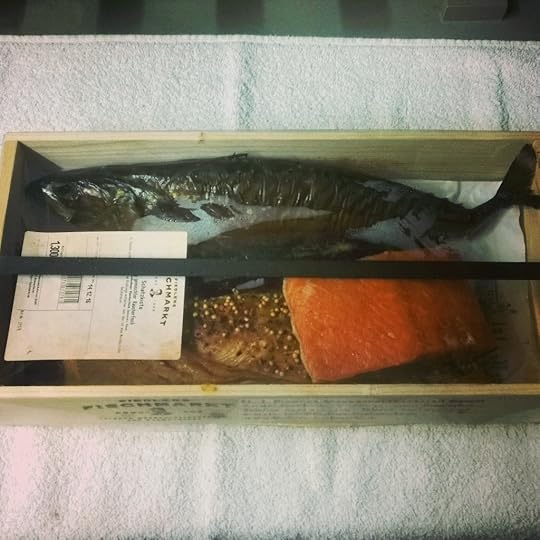
This is actually a Christmas present, namely a smoked fish gift box (quite literally a wooden box) from Bremerhaven. However, I already ate all of it, because it doesn’t keep for very long.

More holiday fish: This is red herring salad, a traditional North German holiday food. We always make a big pot of this and eat it for dinner during the holidays and for however long it lasts. The bright pink colour comes from beetroot. The recipe dates back to my grandma and is probably even older.

Christmas Eve lunch: Deer, stir fried with apples and mushrooms, served with red cabbage, apple cranberry sauce and bowtie pasta. Falls and winter are venison season, so venison of any kind of a traditional holiday food in many families.

Christmas Day lunch was crawfish etouffee. Due to time spent in Mississippi and Louisiana as a kid, I have a weakness for Cajun food, which is pretty much unavailable here in Germany, unless you cook your own. Luckily, crawfish is now available at many supermarkets the year round.
For Boxing Day lunch finally, we had pork curry made according to the recipe served aboard the vessels of the defunct DDG Hansa shipping company. It’s fairly complicated to make, especially considering the basic curry is accompanied by an assortment of pickled, so we only have it for festive occasions like Christmas or my birthday.
I blogged about this curry (which is not exactly authentic Indian curry, but more an interpretation of Indian curries by German sailors) in greater detail and with photos here. This time around, the add-ons and pickles were a bit different. It turned we had no banana left, since my Dad ate the last one, so we used chopped apple instead. Plus, we had Atjar Tjampoer, a Dutch interpretation of an Indonesian pickle, since I bought a jar of it during my recent trip to Winschoten.
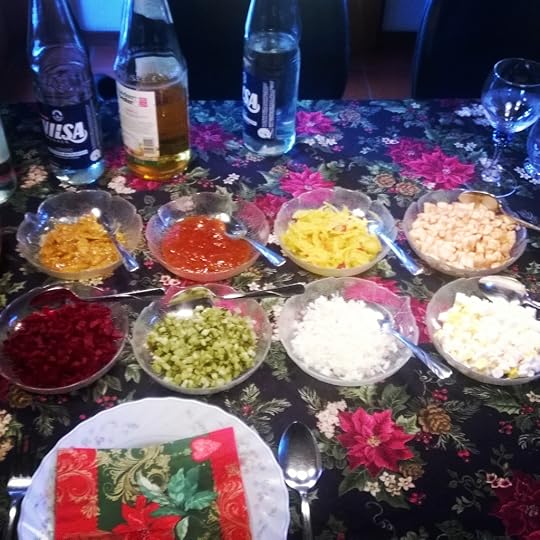
Pickles to be served with sailor’s curry. Top row: Indian lime pickle, mango chutney, atjar tjampoer, chopped apple. Bottom row: Chopped pickled beetroot, chopped gherkins, chopped onion, chopped hardboiled egg
 Send to Kindle
Send to Kindle
December 23, 2016
Another new release for the holidays: Christmas Shopping with a Broken Heart
And here is the final new release announcement for 2016. It’s another holiday story, but one that is very different from St. Nicholas of Hell’s Kitchen.
For Christmas Shopping with a Broken Heart is a sweet and rather fluffy holiday romance in the vein of Christmas Gifts and Christmas Eve at the Purple Owl Café.
Christmas Shopping with a Broken Heart was something of an attack story, because the phrase that eventually became the title suddenly popped into my head. At first, I wanted to write a poem around it, but then I thought, “Hey, that’s a great title for a Christmas romance,” and started writing. Three days later I was finished and here is the result.
Regular readers may notice that Christmas Shopping with a Broken Heart is the second holiday story I have written that is set in a shopping mall just before Christmas. The other one is Christmas Gifts. And coincidentally, it’s strongly implied that both stories take place concurrently at the same mall. Plus, I strongly suspect that Shannon from Christmas Gifts snagged that last jar of cranberry sauce that Hannah and Owen can’t find later on.
Why malls? Well, for starters, visiting a mall at holiday time is an experience most of us can relate to, plus malls give strangers plenty of chances to meet and they offer any kind of setting you could possibly need, because a mall is basically an interconnected universe of little mini-environments. Hence, Christmas Gifts features a perfumery and a coffee shop, while Christmas Shopping with a Broken Heart features the plaza/entrance area, the mall parking lot, a supermarket and once again, a coffee shop. And yes, it’s the same coffee shop manned by the same barista, a Pakistani math student named Mohammad.
In fact, I may eventually turn Christmas Gifts and Christmas Shopping with a Broken Heart as well as any other holiday stories set in and around shopping malls I may still write (e.g. I have an unfinished holiday romance set at a Christmas tree lot on – yes – a mall parking lot). The only reason I didn’t yet officially link both stories in a series is that a) it didn’t occur to me until yesterday and b) I’m reluctant to make any changes to book listings or upload new content at a time where the backend at most e-book vendors is closed for the holidays.
So enjoy Christmas Shopping with a Broken Heart to give you that warm and fuzzy feeling for the holidays.
Christmas Shopping with a Broken Heart When her boyfriend dumps her four weeks before Christmas, Hannah throws herself into holiday preparations in order to dull the pain. But nothing seems to help, until Hannah quite literally bumps into Owen, while Christmas shopping.
When her boyfriend dumps her four weeks before Christmas, Hannah throws herself into holiday preparations in order to dull the pain. But nothing seems to help, until Hannah quite literally bumps into Owen, while Christmas shopping.
Hannah and Owen hit it off immediately. But Owen is nursing an old grief of his own…
This is a short and sweet holiday romance of 5900 words or approximately 20 print pages.
More information.
Length: 5900 words
List price: 0.99 USD, EUR or GBP
Buy it at Amazon US, Amazon UK, Amazon Germany, Amazon France, Amazon Netherlands, Amazon Spain, Amazon Italy, Amazon Canada, Amazon Australia, Amazon Brazil, Amazon Japan, Amazon India, Amazon Mexico, Kobo, Barnes & Noble, Apple iTunes, Scribd, Smashwords, Inktera, txtr, Thalia, Weltbild, Hugendubel, Buecher.de, DriveThruFiction, OmniLit/AllRomance e-books, Casa del Libro, e-Sentral, 24symbols and XinXii.
 Send to Kindle
Send to Kindle
December 22, 2016
New Release: St. Nicholas of Hell’s Kitchen, a Silencer Christmas novella
I promised you more new release announcements in the run up to the holidays and here is number 2. This one is for St. Nicholas of Hell’s Kitchen, a Silencer Christmas novella.
Now I’ve always been fond of the Silencer series of pulp-style adventures set in Depression era New York City. However, the series has never sold all that well, since the audience for retro thrillers in the style of the old hero pulps is limited and many of them are perfectly satisfied with an endless supply of actual vintage pulp fiction. Never mind that the Thrillers –> Pulp subcategory at Amazon is cluttered with all sorts of bog-standard thrillers that have zero connection with actual pulp fiction.
As a result, I don’t actively write more Silencer stories, unless a good idea presents itself. However, one thing I’ve always wanted to do was write a Silencer Christmas story. All that was missing was the right idea.
That idea eventually showed up sometime in October, when I thought it would be fun to have the Silencer make his escape down a chimney and get mistaken for Santa Claus (which is exactly what happens in the opening chapter). My first idea was simply to have Lucy rattle off her wishes to the Silencer and Richard doing his best to fulfil them. However, that wasn’t a particularly satisfying story, so I added in some more conflict, namely that Lucy and what was originally her family were at risk of eviction from their apartment.
The apartment quickly changed into an orphanage. After all, it’s a Christmas story and the Silencer helping nuns and orphans has more impact. So once I had the orphanage, I also had the three remarkable (and absolutely not villainous for once, because the evil nun/priest trope annoys me to no end) nuns Sister Mary Margaret, Sister Agnes and Sister Bernadette. Coincidentally, St. Nicholas of Hell’s Kitchen also effortlessly passes the Bechdel test, since it has plenty of named women (the three nuns, Constance, Leah Levonsky, Dorothy Berwick, Melody Rumpus) talking among themselves about all sorts of things, including on occasion men.
Once the three nuns had laid out their plight, the information naturally led Richard (and me, since I’m very much a discovery writer) to Father O’Leary and the church of St. Nicholas of Hell’s Kitchen (which is entirely fictional BTW) which also gave the novella its title. As for why I chose to set the story in Hell’s Kitchen, I picked that particular neighbourhood, because it was an immigrant neighbourhood and crime-ridden well into the 1980s. The name of the street gang the Silencer is tangling with at the start is a reference to another well known heroic resident of Hell’s Kitchen. Plus, the religious connotations of the name were too good to pass up. Coincidentally, the Heaven & Hell Cabaret and particularly the scene where Richard stumbled into a dressing room full of chorus girls in angel and devil costumes also came about because of the theme.
Initially, I had planned for slumlord Paul Krays to be the main villain of the story. However, then the US presidential elections happened and my plans changed in that I made Krays merely a henchman of an even bigger villainous mastermind. And yes, any resemblances between Reginald Rumpus and a certain US real estate mogul turned reality TV star turned president are totally not coincidental at all.
Though you’ll also notice that the physical descriptions of Reginald and Melody Rumpus don’t quite match their real world counterparts. Instead, they were based on Wallace Beery and Jean Harlow playing a crass noveau rich couple living in a very white Art Deco apartment (so white that the cinematographer had problems filming it) in the 1933 movie Dinner at Eight. Here is a trailer for the movie BTW, which made me realise that though I’ve seen the film (I’m a big fan of Jean Harlow), I remember absolutely nothing about it except Jean Harlow and her spectacular gowns, Wallace Beery and that very white apartment. So in short, Reginald and Melody Rumpus are Donald and Melania Trump as portrayed by Jean Harlow and Wallace Berry.
I think I’ve mentioned before that the Silencer stories are among the most research intensive of my stories. Only the Alfred and Bertha stories require even more research, but the necessary info for those stories is usually much easier to find. The big problem with the Silencer stories is that the 1930s are still close enough to our time that many things are similar, i.e. there are guns, cars, airplanes, radios, movies, typewriters, etc…, but nonetheless far enough away that plenty of things we take for granted today didn’t yet exist. And yes, I admit that I occasionally cheat a little. For example, night vision devices were still highly experimental in the mid 1930s and only gradually came into wider use during WWII. And while acrylic glass was certainly around and Lucite was trademarked in 1936, there likely weren’t shoes with Lucite heels yet.
What is more, New York City has changed a lot since the 1930s, though thankfully the city or at least parts of it are well enough documented that it’s easy enough to find out what things look like today, whether they looked like that in the 1930s, when particular buildings were built, etc… That’s for example why the scene of Constance and Leah Levonsky walking along Fifth Avenue never mentions Tiffany’s, since Tiffany’s didn’t move to its current location until 1940. And indeed, all the buildings, hotels, stores and sights mentioned in the Fifth Avenue scene actually existed with the exception of Reginald Rumpus’ dark tower, which was based on some actual Art Deco skyscrapers with a bit of gothic flair added. The Bonwit Teller department store BTW was torn down by none other than Donald Trump to make room for the Trump Tower. And by the way, I’d like to make a shout-out to the Sherry-Netherland Hotel whose website has plenty of photos of its beautiful restored interior, which were exactly the sort of information I needed for this story. I’m not actually in the market for 400 USD per night hotel rooms in Manhattan, but if I were, this is the hotel I’d choose.
But even though there are plenty of photos of Manhattan in the 1930s around, photos of Christmas decorations in 1930s Manhattan are far more difficult to find. Hence, while it was easy enough to figure out that the Christmas tree at the Rockefeller Center has been around since 1931 (with a gap in 1932), though actual photos of what it looked like at the time were a lot more difficult to find. This page has some, though. The ice skating rink, meanwhile, only opened in 1936, i.e. it would have been brand new at the time the story was set.
Photos of 1930s Christmas decorations on Fifth Avenue were even more difficult to find. I could find a few interior shots of various department stores, but hardly any photos of street decorations, at least not in New York City. So the descriptions of display windows and decorations are largely much made up.
Regarding the F.A.O. Schwarz scenes, now I’ve actually been inside the Fifth Avenue flagship store of F.A.O. Schwarz. However, the building I visited was clearly built after WWII. Luckily, it was not just easy enough to find out where F.A.O. Schwarz would have been in 1936 (practically next door, it turned out), but I also came across this 1940 article from Fortune magazine which decribes exactly what the store looked like, how it was set up, etc… There’s also a photo gallery which includes plenty of shots of Christmas decorations from the 1930s and 1940s. The various toys described are all real toys from the 1930s BTW. I didn’t even have to research those, since I used to collect toys (still do, though I refrain from buying additions for space reasons).
The Paradise Lounge is obviously a proto Tiki Bar. Now Tiki Bars are mainly associated with the 1950s and 1960s, but the beginnings of the trend lie in the 1930s. Don, the Beachcomber and Trader Vic’s (still named Hinky Dink) both opened in the 1930s in California. Actress Dorothy Lamour also first donned her famous sarong (which has very little to do with an actual sarong) in the 1936 movie Jungle Princess.
But it wasn’t just settings and technology that required research. For example, I come from a Lutheran Protestant majority region and have never been Catholic, so I had no idea how confessions really work beyond what you see in movies in occasion, what the priest says, etc… Luckily, there are plenty of religious websites which have the relevant information.
The Hanukkah dinner at the Levonskys’ home (which I wanted to include just to show how diverse 1930s New York would have been) posed a similar problem. For though I know what Hanukkah is and what is being celebrated, I didn’t know what middle class Jewish families would have eaten. Once again, the web came to my rescue and to own surprise I found that most of the food was familiar to me, though I know it by different names.
Coincidentally, while the wife and daughter of pulp publisher Jake Levonsky have been mentioned in the Silencer series before (in Countdown to Death and The Great Fraud, to be exact), this is the first time we actually meet them on the page. I really enjoyed writing the bubbly Leah Levonsky BTW and I’m sure she’ll show up again.
Of the other Silencer regulars, Justin O’Grady shows up briefly towards the end (and reveals that he knows exactly who the Silencer is, even if he cannot prove anything). Constance has a more substantial role, though she is not actively involved in the action this time around. And Edgar, the kitten Richard rescued in Elevator of Doom, shows up as well. Plus, there is the possibility of a new addition to the family towards the end.
 Talking of Elevator of Doom, that story has a gorgeous new cover, by the way, which also matches the Silencer series branding much better than the old cover did. And indeed, finding suitable covers for the Silencer series is another massive challenge, since illustrated or CGI retro stock art is extremely rare (and 1930s style imagery is even more difficult to find – Victorian, Edwardian, 1920s and 1950s are far more plentiful). Though I’m happy both with the new cover of Elevator of Doom as well as with the vintage Christmas tree on the cover of St. Nicholas of Hell’s Kitchen.
Talking of Elevator of Doom, that story has a gorgeous new cover, by the way, which also matches the Silencer series branding much better than the old cover did. And indeed, finding suitable covers for the Silencer series is another massive challenge, since illustrated or CGI retro stock art is extremely rare (and 1930s style imagery is even more difficult to find – Victorian, Edwardian, 1920s and 1950s are far more plentiful). Though I’m happy both with the new cover of Elevator of Doom as well as with the vintage Christmas tree on the cover of St. Nicholas of Hell’s Kitchen.
In short, St. Nicholas of Hell’s Kitchen takes us on a seasonal tour through the wintery New York City of 1936 and really has it all: action, thrills, romance, toy stores, tiki bars, burlesque theatres, orphans, nuns, chorus girls, villains and even a time-displaced Donald Trump analogue.
So what are you waiting for? Get your copy today!
St. Nicholas of Hell’s Kitchen
[image error]Christmas time in 1930s New York. After escaping through the chimney of an orphanage in Hell’s Kitchen, Richard Blakemore a.k.a. the masked crimefighter known only as the Silencer is mistaken for Santa Claus by one of the children and learns that the orphanage is under siege by both a gang of brutal racketeers and an unscrupulous landlord.
Richard vows to help the children and their guardians. However, it turns out that the attacks on the orphanage are only part of a much larger plot, when Richard’s quest for justice leads him into the upper echelons of Manhattan’s high society.
Soon, the Silencer finds himself face to face with one of the most powerful men in the city, while Richard and Constance struggle to save the orphanage and give the children of Hell’s Kitchen an unforgettable Christmas.
More information.
Length: 29000 words
List price: 2.99 USD, EUR or GBP
Buy it at Amazon US, Amazon UK, Amazon Germany, Amazon France, Amazon Netherlands, Amazon Spain, Amazon Italy, Amazon Canada, Amazon Australia, Amazon Brazil, Amazon Japan, Amazon India, Amazon Mexico, Kobo, Barnes & Noble, Apple iTunes, Scribd, Smashwords, Inktera, txtr, Thalia, Weltbild, Hugendubel, Buecher.de, DriveThruFiction, OmniLit/AllRomance e-books, Casa del Libro, e-Sentral, 24symbols and XinXii.
Don’t forget that you can buy a bundle of all eight Silencer novelettes at DriveThruFiction at a reduced price.
 Send to Kindle
Send to Kindle
December 20, 2016
Seasonal Views of Winschoten in the Netherlands
I guess I’ll be alternating between seasonal photos and new release announcements up to Christmas.
Anyway, today I had an appointment in Winschoten, a town just beyond the Dutch-German border, which meant a 280 kilometer round trip shortly before Christmas. Not exactly ideal, but at least I got to take a few rather gloomy smartphone shots of Winschoten all decked out for the season.
The reason the photos are gloomy is because it was a grey and foggy day just before the winter solstice. If you want to see what the town looks like in slightly nicer weather (though that was a foggy day as well – fog being rather common this close to the North Sea coast), here are some photos from 2014.
So let’s take a look at Winschoten at Christmas time:

A Christmas tree along the canal with a typically Dutch drawbridge in the background.

Winschoten’s main shopping street is lined by 19th century brick houses and the 16th century bell tower of the Marktplein Church. Not the Christmas lights.

A closer look at the “D’Olle Witte” (the old white one), the 16th century bell tower of the Marktplein Church. The bell tower is actually separate from the church. In front, you can see the bookstore Bruna.

A look at Winschoten’s main shopping street street with Christmas lights. The rose motif refers to the fact that Winschoten is home to the largest rosarium in the Netherlands. In the background, you can see the tower of the 19th century town hall. On the right, you can see the HEMA discount department store with the tiled look typical for the chain.

The postmodern Winkelzentrum (shopping mall) ‘t Rond (The Round). The older building on the left houses an Automat diner, which still exist in the Netherlands (Winschoten has two in perfectly preserved 1950s look). The long line on the right is people queueing up for Poffertjes, little Dutch pancakes.

Finally, here is a shot of my lunch, scrambled eggs with veggie stir-fry, courtesy of the truck stop Autohof Apen-Remels.
No photos of the windmills (Winschoten has three) this time, since they are on the other side of town and I was eager to go home, once my business was concluded, because it gets dark at approx. a quarter past four at this time of the year and I don’t particularly like driving in the dark.
Though I did manage to squeeze in some shopping. Food mostly, Brussels sprouts, fresh cranberries, Gouda cheese, breakfast cake with candied ginger, rice crackers, atjar tjampoer (I should probably pickle my own some day), ketjap manis and gochujang, all of which are either not available in Germany outside specialty stores or at least not in the same quality (e.g. there is a huge difference between Dutch Gouda and what passes for Gouda in Germany and the Brussels sprouts were so much better than what you can buy in German supermarkets).
I also surrendered to the lure of the local Bruna store. Bruna is a chain of book, magazines and stationery stores in the Netherlands. As a teen I spent a lot of time at the Rotterdam Bruna store (my Dad worked in Rotterdam from 1983 to 1989) reading comics, which is why I’m familiar with most Franco-Belgian-Dutch comics going strong in the 1980s. I hardly ever bought any of them, since I couldn’t afford them (Franco-Belgian-Dutch style albums are a lot pricier than US-style single issues), but I read most of them and the staff let me. Plus, occasionally I managed to scrape enough money together to buy a comic album or an issue of Starlog (which they carried as well) or once, an imported book on science fiction movies for the enormous price of 65 Dutch guilders. That’s still pretty expensive for a book – even a non-fiction hardcover book – even twenty-eight years later, but considering I literally read it to pieces, it was well worth the price. I still have it, too.
So nowadays, whenever I find myself in the Netherlands and come across a Bruna store, I usually go in to check out the comics (alas, they no longer carry Starlog). And if something catches my eye, I buy it as a payback for all the comics I read in the store as a teen. Most of the series I read back then are no longer around, though Suske en Wiske (a.k.a. Bob et Bobette a.k.a. Spike and Suzy) is still going strong. I will always have a soft spot for them – since Suske en Wiske were for me what Archie is for many Americans, only that Suske en Wiske had aliens, fantasy lands and time travel – but I don’t buy the comics, because I aged out of the target demographic some thirty years ago. Indeed, I preferred Willy Vandersteen’s other series De Rode Ridder (The Red Knight) and particularly De Geuzen towards the end of my time in Rotterdram.
However, today I came across a new volume in the Worlds of Aldebaran science fiction series by Leo, which I quite like, so I bought that.
 Send to Kindle
Send to Kindle
December 19, 2016
New science fiction story available: Liquid Muse
Originally, I was planning to post some photos of the Bremen and Oldenburg Christmas markets today. But it didn’t really feel appropriate, given today’s news.
So I decided to postpone the photo post and do a new release announcement instead.
This is actually the first of three new release announcements to come in the run-up to Christmas. Yes, I’ve been busy, which is why this blog has been somewhat neglected of late.
Today’s announcement is for a near future SF story called Liquid Muse. It’s another story to come out of the 2016 July short story challenge.
Unlike most other stories originating from that challenge, Liquid Muse has no clearly defined inspiration. Instead, it was the result of the juxtaposition of an article on gentrification, a news headline on possible genetic link to human creativity and a call for blood donations that landed in the creativity pessure cooker of my mind and caused Liquid Muse to fall out.
It didn’t really fit in thematically with any of the other stories to come out of the July short story challenge, so I decided to publish it as a standalone. Coincidentally, it’s also one of the more explicitly political stories I’ve written.
Since Liquid Muse is largely about abstract concepts, I was unsure what to do about the cover. But then I came across a gorgeous piece of psychedelic art, which was actually supposed to be a visualisation of migraine.
I’ve always had a soft spot for the psychedelic science fiction covers of the 1960s and 1970s, not to mention for the psychedelic posters of Wes Wilson and Peter Max, so that was the look I went for.
Liquid Muse Jonah Winter has developed the perfect creativity enhancing drug – one hundred percent effective, non-addictive and safe.
Jonah Winter has developed the perfect creativity enhancing drug – one hundred percent effective, non-addictive and safe.
Ron Varnhagen has experienced the drug’s remarkable properties for himself and plans to invest in Jonah’s venture. But then he learns of the horrifying secret behind the drug and its production…
This is a short science fiction story of 2600 words or approx. 10 print pages altogether.
More information.
Length: 2600 words
List price: 0.99 USD, EUR or GBP
Buy it at Amazon US, Amazon UK, Amazon Germany, Amazon France, Amazon Netherlands, Amazon Spain, Amazon Italy, Amazon Canada, Amazon Australia, Amazon Brazil, Amazon Japan, Amazon India, Amazon Mexico, Kobo, Barnes & Noble, Apple iTunes, Scribd, Smashwords, Inktera, txtr, Thalia, Weltbild, Hugendubel, Buecher.de, DriveThruFiction, OmniLit/AllRomance e-books, Casa del Libro, e-Sentral, 24symbols and XinXii.
 Send to Kindle
Send to Kindle
December 9, 2016
The Return of the Trolls and a New Release: The Cursed Arm of Driftwood Beach
I’ve been somewhat missing in action these past few weeks, because I’ve been hard at work finishing the Silencer Christmas novella St. Nicholas of Hell’s Kitchen, so I can publish it before the various e-book retailers close down for the holidays (which happens up to two weeks before Christmas for some of them).
On this blog, I also have some seasonal photos of German Christmas markets coming up as well as my comments on the return of the Sad Puppies probably (the post is mostly written, so why not?).
What is more, the troll-themed anthology For Whom the Bell Trolls: 25 Tales of Terror, Triumph and Trolls, edited by Lindy Moone and John L. Monk is available again. My story in the anthology is called “When Life Gives You Trolls, Make Lemonade” and it’s about a lonely troll looking for companionship on the Internet.
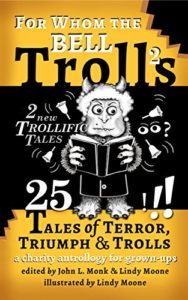 It’s a Smorgasbord of Trolls!
It’s a Smorgasbord of Trolls!
Funny, touching, titillating and suspenseful, there’s a story for every adult reader in For Whom the Bell Trolls, a unique, illustrated “antrollogy” by 24 international authors. Arranged from light to meaty fare, the book’s “menu” offers up fanciful and farcical stories, family-oriented tales, romance, mystery, even magically surreal literary stories — starring all sorts of trolls, from the all-too-real Internet variety to the man-eating, bridge-dwelling trolls of legend.
Buy it at Amazon US, Amazon UK, Amazon Germany, Amazon France, Amazon Netherlands, Amazon Spain, Amazon Italy, Amazon Canada, Amazon Australia, Amazon Brazil, Amazon Japan, Amazon India and Amazon Mexico.
Royalties go to charity (Equality Now), so what are you waiting for? Grab your copy today.
However, I also have a new release in a different series (well, it is a series now) to announce, namely the sequel to The Revenant of Wrecker’s Dock and the second story in the Hallowind Cove series about a fog-shrouded seaside town that is a magnet for weird happenings.
I initially wrote The Revenant of Wrecker’s Dock as a standalone, though I always intended to reuse the town of Hallowind Cove, should the right story idea come along. And eventually, the right idea did come along, while I was doing the 2016 July short story challenge.
Also in July, I visited Bremerhaven. Though Bremerhaven is a seaside city, it is not at all like the fictional Hallowind Cove. For starters, it’s a lot bigger, something of a tourist attraction and also a major sea port.
One of Bremerhaven’s main tourist attractions and one of its four big museums is the German Maritime Museum and its exterior grounds at the so-called museum harbour, which hold those exhibits too big for the museum proper. Most of those exterior exhibits are historical ships (you can see some of them in this post). However, there are also buoys, smokestacks, cranes, a harpoon and a wooden sculpture called the sailor’s arm, which is basically an almost six meter long wooden arm.
When I’m in Bremerhaven and have enough time, I like walking around the touristy Havenwelten neighbourhood and the museum harbour. And so I was wandering among the historical ships at the museum harbour, primed to generate story ideas because of the July short story challenge, when I walked past the sailor’s arm. And suddenly, the sculpture sparked an idea. “What if the arm wasn’t just an offbeat work of art, but the actual arm of some kind of giant? And what if the arm wasn’t happy about being separated from its body?”
On the train, I mused a bit more about that idea and suddenly realised that this was a Hallowind Cove story. So, once I got home, I sat down and started writing what would eventually become The Cursed Arm of Driftwood Beach.
In the story, we meet some old friends, namely Paul, Old Hank and Hugo from The Revenant of Wrecker’s Dock, again and also encounter some more of the residents of Hallowind Cove.
So prepare to be thrilled by:
The Cursed Arm of Driftwood Beach
 A disembodied arm terrifies a seaside town…
A disembodied arm terrifies a seaside town…
Strange things keep happening in the permanently fog shrouded seaside town of Hallowind Cove, earning it the nickname “Harbour of the Weird”.
When a beachcomber finds a giant wooden arm on the beach, the people of Hallowind Cove are excited about a new addition to the town museum’s collection.
But the wooden arm has a mind of its own – and the tendency to go walkabout by night…
This is a short story of 2400 words or approximately 10 pages in the Hallowind Cove series, but may be read as a standalone.
More information.
Length: 2400 words
List price: 0.99 USD, EUR or GBP
Buy it at Amazon US, Amazon UK, Amazon Germany, Amazon France, Amazon Netherlands, Amazon Spain, Amazon Italy, Amazon Canada, Amazon Australia, Amazon Brazil, Amazon Japan, Amazon India, Amazon Mexico, Kobo, Barnes & Noble, Apple iTunes, Scribd, Smashwords, Inktera, txtr, Thalia, Weltbild, Hugendubel, Buecher.de, DriveThruFiction, OmniLit/AllRomance e-books, Casa del Libro, e-Sentral, 24symbols and XinXii.
 Send to Kindle
Send to Kindle
November 29, 2016
Indie Speculative Fiction of the Month for November 2016
 It’s that time of the month again, time for “Indie Speculative Fiction of the Month”.
It’s that time of the month again, time for “Indie Speculative Fiction of the Month”.
So what is “Indie Speculative Fiction of the Month”? It’s a round-up of speculative fiction by indie authors newly published this month, though some Oktober books I missed the last time around snuck in as well. The books are arranged in alphabetical order by author. So far, most links only go to Amazon.com, though I may add other retailers for future editions.
Once again, we have new releases covering the whole broad spectrum of speculative fiction. We have a whole lot of horror this month, but also urban fantasy, portal fantasy, YA fantasy, space opera, military science fiction, post-apocalyptic science fiction, dystopian fiction, paranormal romance, gay werewolves, aliens, ghosts, FBI witches, aliens, southern monsters, sentient zombies, pods, starships, newcomers, clockwork alchemists and much more.
Don’t forget that Indie Speculative Fiction of the Month is also crossposted to the Speculative Fiction Showcase, a group blog run by Jessica Rydill and myself, which features new release spotlights, guest posts, interviews and link round-ups regarding all things speculative fiction several times per week.
As always, I know the authors at least vaguely, but I haven’t read all of the books, so Caveat emptor.
And now on to the books without further ado:
 Southern Monsters by Cora Buhlert:
Southern Monsters by Cora Buhlert:
Three tales of monsters and terror in the Louisiana bayous.
When a young bride goes missing on her wedding day in Acadiana, the locals blame the Terror, the legendary monster that stalks the Crimson Bayou.
Remy Theriault does not believe in the Terror and he’s pretty sure the bride has done a runner. But the groom is his cousin and family is family. So Remy goes out to look for the runaway bride, only to find that sometimes, the old legends are true…
When their car crashes into the bayou on a dark Louisiana night, the swamp creature known only as Big Puffball might just be one family’s salvation…
When fishing boats go missing on the Mississippi River Delta, few people link these disappearances to the mysterious light that lit up the Louisiana sky only weeks before. But an astronomer from Tulane University makes the connection and discovers the horror that is the sphere that ate the Mississippi delta.
This is a collection of three short horror stories of 7700 words or approximately 27 print pages altogether.
Alisa Marchenko has reunited with her daughter, and even though she hasn’t figured out how to get Jelena to accept Leonidas yet, she dreams of the three of them starting a new life together. They can return the Star Nomad to its original purpose of running freight and staying out of trouble (mostly).
Before that can happen, Alisa must fulfill the promise she made to Jelena: that she and her crew will retrieve young Prince Thorian, the boy who has become Jelena’s best friend. But Thorian was kidnapped by the rogue Starseer Tymoteusz, the man who wants to use the Staff of Lore to take over the entire system—and the man who may have the power to do it. Alisa doesn’t know why he kidnapped Thorian, but Tymoteusz once promised to kill the prince, so she fears they don’t have much time.
Unfortunately, Tymoteusz hasn’t left a trail of breadcrumbs. Finding him will be difficult, and even if they’re successful, facing him could be suicidal. To have a chance of surviving, Alisa will have to come up with her greatest scheme yet.
The summer after graduation SHOULD have been the most exciting time of Mercy’s life.
Instead, on the way to an exciting overseas trip, she’s the only survivor of a tragic accident that claims the rest of her family. Then at her family’s memorial service, a ghostly hooded figure begins to follow her.
Her gorgeous new neighbor, Kit, who happens to run a paranormal blog, helps her discover what the hooded figure is hiding. Mercy thinks he’s angry that she survived the accident.
Could she be right?
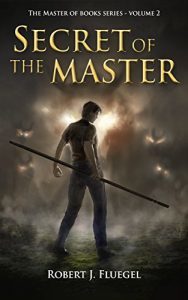 Secret of the Master by Robert J. Fluegel:
Secret of the Master by Robert J. Fluegel:
It’s been two weeks since Tommy Travers broke a deadly curse in his town, one he accidentally brought with him from the World of Books. Being trained how to control his new power is more important than ever. As Tommy enters a book under the guidance of his trainer Amelia, however, the repercussions of the curse are not yet over. A wizard escaped from the World of Books read Tommy’s mind and he knows where the Gifted are. If the evil wizard finds a way to unlock his magic, the warehouse, the Gifted—the world—will be his.
Tommy and his new friends must find a way to gain back all they’ve lost. But time is running out, and there’s something Amelia hasn’t told him. A secret—one that makes him, an amateur Gifted who’s hardly begun training, the only one who can defeat Mephitis before it’s too late.
In this sequel to Gift of the Master, join Tommy as he finds his true place among the Gifted and braves his most dangerous book yet.
Humankind entered the age of deep space travel two decades ago, and Earth’s megacorps rushed to exploit the rich resources to be found on unclaimed planets. Prospecting starships roam the galaxy, racing to be the first to lay their hands on the new-found source of wealth.
But unknown horrors lie at the reaches of the great expanse, ready to be awakened by unsuspecting starship crews.
Chief Security Officer Jas Harrington’s job is to protect her shipmates from hostile aliens on new worlds. For the efficient if quick-tempered Jas, that hasn’t been too hard up till now. But her captain is drug-addled, and he’s hungry for the bonuses he gets from finding valuable resources.
When the captain won’t listen to Jas’ fears about a mysterious planet, he is compromised by contact with a strange life form—a life form that threatens to take over the entire ship and return to Earth, where it can spread its deadly infection.
Now Jas is in a race against time, struggling to quarantine the alien infection and prevent the aliens from achieving their goal: Generation. She doesn’t realize it yet, but as she fights to save her crew, the future of all humanity hangs in the balance.
Generation is the first of ten books in the Shadows of the Void space opera serial.
 PODS! and Other Supernatural Tales by D.F. Holland:
PODS! and Other Supernatural Tales by D.F. Holland:
PODS AND OTHER SUPERNATURAL TALES will take you on a spine-tingling voyage, where you’ll encounter deadly sea creatures, cursed objects, custom-made Hells, alien killers and other worlds – all in the blink of a gargoyle’s eye!
Hang on tightly as you read this collection of chilling, supernatural horror and fantasy – from the author of TALES FROM THE BEAUMONT HOUSE.
Probitionary FBI Agent Agatha Blackmore has just finished three grueling years at the FBI Academy at Quantico. She mastered every skill and task they laid before her. She now begins an Internship of sorts working for the Magical Crimes Division. Assassination, Murder, and Betrayal await her. How will she do in the real world? Will her Magick be enough to save her?
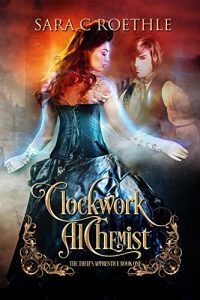 Clockwork Alchemist by Sara C. Roethle:
Clockwork Alchemist by Sara C. Roethle:
Arhyen is the self-declared finest thief in London. The mission was simple. Steal a journal from Fairfax Breckinridge, one of the greatest alchemists of the time.
Arhyen hadn’t expected to find Fairfax himself, with a dagger in his back. Nor had he expected his automaton daughter, Liliana. Suddenly entrenched in a mystery too great for him to fully comprehend, he must rely on the help of a wayward detective, and an automaton who claims she has a soul, to piece together the clues laid before them. Will Arhyen uncover the true source of Liliana’s soul in time, or will London plunge into a dark age of nefarious technology, where only the scientific will survive?
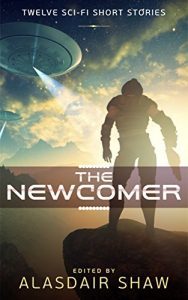 The Newcomer: Twelve Science Fiction Short Stories, edited by Alasdair Shaw:
The Newcomer: Twelve Science Fiction Short Stories, edited by Alasdair Shaw:
From a young couple struggling to look after their baby to a new captain’s reluctance to take command of her ship, and from a sun-addled stranger’s appearance in town to the emergence of a sentient AI, the twelve tales presented here explore the central theme of an arrival by someone or something new.
There’s even an alien puppy.
The stories are:
Tithe by Griffin Carmichael
Exodus by Alec Hutson
First Bonding by Tom Germann
Ice Dreamer by J J Green
The Nanny by Cindy Carroll
Right Hand by Jonathan C Gillespie
What Make is Your Cat? by Richard Crawford
Kaxian Duty by Cherise Kelley
Lessons Learned by J Naomi Ay
The Humra by Laura Greenwood
The Hawk of Destiny’s Fist by James S Aaron
Repulse by Alasdair Shaw
From the moment they meet, Nat feels a strong connection with the injured wolf…and later with the same gorgeous man. Nat is just an ordinary cop, with his own problems and insecurities, but if he can help Journey in any way, he’d love to.
He’d also love to date the sweet, handsome shifter, although that might be more complicated than he first thought. Two men navigate the waters of learning to trust, love, and accept themselves and each other, as they work to build a life together.
A Shifters and Partners Novel
 Daughters of Death by Josiah Upton:
Daughters of Death by Josiah Upton:
In Zaul’s mind, the game is over. After giving himself up to the APA, his true identity now lays bare before the walls of the nation’s largest Hybrid Reanimate facility, where he will rot for the rest of his undead days under the watch of cruel containment officers. No more disguises, no more deceptions, no more pretending to be human… And no future with the girl he loves.
But Genny cannot accept this new reality as easily. Compelled to repay his sacrifice, she searches for any way possible get Zaul out of the Facility, allying with both the living and the undead to make it happen. Zaul also forges unlikely friendships when he joins the Brains Club, a privileged group of higher-functioning containees who enjoy a better diet, recreational opportunities, contact with the opposite sex – and unsettling attention from the Assistant Director of the APA.
As Genny’s world unravels, Zaul’s becomes stranger. But only one constant is guaranteed: Caesar Ortega is hell-bent on destroying them both. When death and temptation are around every corner, can you keep who you were alive?
 Send to Kindle
Send to Kindle
Cora Buhlert's Blog
- Cora Buhlert's profile
- 14 followers









